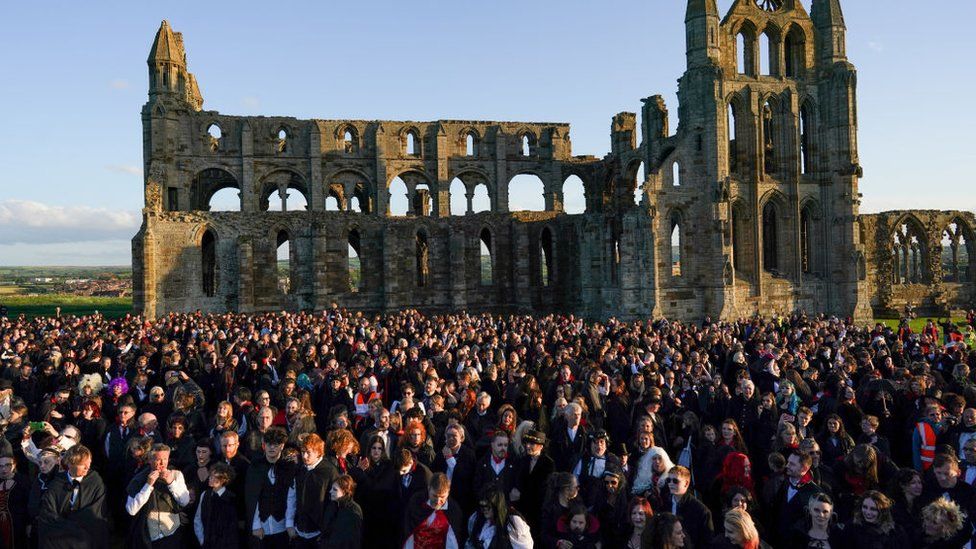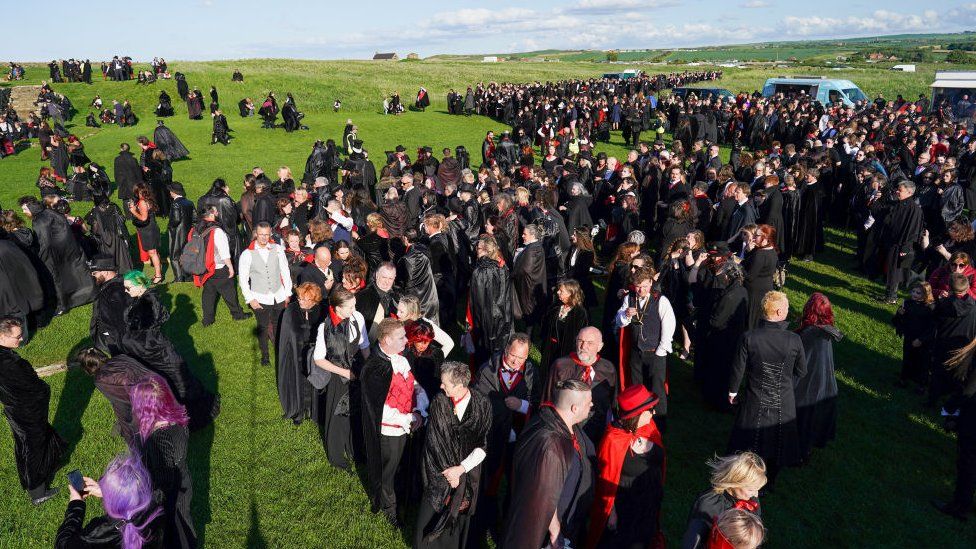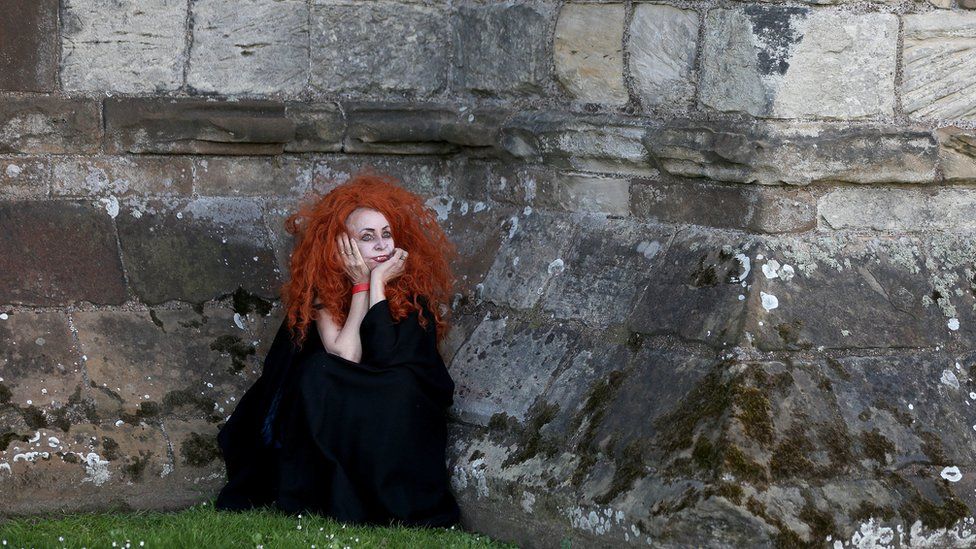








Creating a machine that can perform the delicate work of picking an apple is tricky – and farmworkers say it could be a benefit.
Robots can do a lot. They build cars in factories. They sort goods in Amazon warehouses. Robotic dogs can, allegedly and a little creepily, make us safer by patrolling our streets. But there are some things robots still cannot do – things that sound quite basic in comparison. Like picking an apple from a tree.
“It’s a simple thing” for humans, says robotics researcher Joe Davidson. “You and I, we could close our eyes, reach into the tree. We could feel around, touch it, and say ‘hey, that’s an apple and the stem’s up here’. Pull, twist. We could do all that without even looking.”
Creating a robotic implement that can simply pick an apple and drop it into a bin without damaging it is a multimillion-dollar effort that has been decades in the making. Teams around the world have tried various approaches. Some have developed vacuum systems to suck fruit off trees. Davidson and his colleagues turned to the human hand for inspiration. They began their efforts by observing professional fruit pickers, and are now working to replicate their skilled movements with robotic fingers.
Their work could help to transform agriculture, turning fruit-picking – a backbreaking, time-consuming human task – into one that’s speedy and easier on farm workers.
These efforts have gained impetus recently as researchers point to the worsening conditions for farm workers amid the climate crisis, including extreme heat and wildfire smoke, and also a shortage of workers in the wake of the pandemic. The technology could lead to better working conditions and worker safety. But that outcome depends on how robots are deployed in fields, farm workers’ organizations say.

A new world record has been set for the largest gathering of people dressed as vampires.
A total of 1,369 people attended Whitby Abbey in North Yorkshire dressed as the ghoulish character, breaking the previous record of 1,039 set in 2011.
The event was organised to mark 125 years since Bram Stoker’s novel Dracula was published in 1897.
The Gothic horror tale was said to have been inspired by Stoker’s trip to Whitby in 1890.

The event was organised by English Heritage as part of a year of special events in honour of the book.
The previous record stood at 1,039 vampires set at Doswell in Virginia, USA in 2011.
The “vampires” needed to stand together in the same place for five minutes to break the record.
And shortly after 21:00 BST on Thursday, confirmation came that the record had been broken.
Ahead of the record attempt, the abbey’s manager Mark Williamson said the event had attracted interest from all over the world, including participants who had travelled to the North Yorkshire resort from California.
The event also featured music from local band Westernra and a performance of excerpts of Dracula by theatre group Time Will Tell.




Jack Brookbank, official adjudicator for Guinness World Records, said: “We are quite strict about the official costume that is allowed.
“It must include black shoes, black trousers or dress, waistcoat, shirt, black cape or collared overcoat and fangs on the top set of teeth.”
Jack Brookbank, official adjudicator for Guinness World Records, said: “We are quite strict about the official costume that is allowed.
“It must include black shoes, black trousers or dress, waistcoat, shirt, black cape or collared overcoat and fangs on the top set of teeth.”


Hundreds of Dracula fans descend on Whitby every year, with many visitors to the resort asking where Dracula’s grave is located, forgetting he is a fictional character.
Last year, staff at St Mary’s Church posted a note on the door telling tourists not to ask.

The house where Bram Stoker stayed, and where much of the book was researched, still stands and a plaque marks his time there.
BBC
The average metro train doesn’t go beyond a few stories underground. But sometimes the geology and the geography of the region, such as the presence of rivers and swamps, forces engineers to go deep underground. The Arsenalna, a station on Kiev Metro’s Sviatoshynsko-Brovarska Line, is such an exception.
Arsenalna station is located 105.5 meters below the surface, making it the deepest metro station in the world. If you made a vertical shaft on earth as deep, you could drop the entire Statue of Liberty into it and still have more than twelve meters of headroom left to drop other stuff. To board a subway train at this station, commuters have to take two seemingly never-ending escalators to the bottom. The journey takes up to five minutes.



The mother of all escalators.

The world’s second deepest metro station is located on Saint Petersburg Metro, which is one of the deepest metro systems in the world and the deepest by the average depth of all the stations. The system’s deepest station, Admiralteyskaya, is located 86 meters below ground. The Saint Petersburg Metro including Admiralteyskaya has some of the longest escalators in the world, exceeding 130 meters.


Damn those Russians build massive sturdy escalators!
The former Soviet Union has some of the most deepest underground metros in the world. Park Pobedy, located on the Moscow Metro, lies 84 meters underground, warranting it the third position in the ‘list of deepest metro stations in the world’. The Moscow Metro is also the deepest in Russia, having a maximum depth of 97 meters.
Like many Russian subway stations, Park Pobedy is beautifully decorated.


Yet another contender to the title of the world’s deepest metro system is Pyongyang Metro, in North Korea’s secretive capital city, with tracks lying at over 110 meters underground. Commuters ride down to the Puhŭng Station—one of only two that foreigners are allowed entry— on escalators accompanied by the “sound of revolutionary anthems booming from antique loudspeakers.” The journey takes nearly four minutes.
Because of its depth, the metro stations double as bomb shelters, with blast doors in place at hallways. The metro is so deep that the temperature of the platform remains a constant 18°C all year.














A couple comic book covers.


The lost city of Caral boasts pyramids just as old as those in Egypt and is the oldest city in the New World.

Relatively speaking, the Incas are recent history. One unfortunate consequence of the fame of the Incas is that they tend to crowd out the long and rich history of the region with its many kingdoms and civilizations that went before. Some pre-Inca cultures were incorporated into the Inca Empire, while others were ancient history by the time the Incas appeared on the scene.
The oldest city now known in the Americas is that of Caral. It flourished at around the same time as the Egyptian pyramids were being built. The ruins of ‘Sacred City of Caral-Supe’ or simply ‘Caral,’ is a reminder of just how old the history of what is today Peru really is. Another ancient pre-Inca city in the Peruvian desert to explore is Chan Chan. Peru is a country with a very rich history.
Caral is considered both the oldest (known) city in the Americas and one of the oldest in the whole world. It history stretches back around 5000 years rivaling the age of Ancient Egypt and its pyramids. No other site in the Americas has been found with Caral’s diversity of monumental buildings and ceremonial and administrative functions.
The city of Caral was part of the ancient Caral culture. It is believed to have developed between 3000 and 1800 BC and is considered the oldest of the pre-Hispanic civilizations.
Caral Culture: Developed Between 3000 and 1800 BC
To put that into context, that is much older than the civilizations of Mesoamerica. The Olmec civilization is considered a progenitor to the complex civilizations of Mesoamerica (the Olmecs were responsible for the “colossal heads” and the first use of chocolate). But the Caral Culture is believed to have developed around 1,500 years earlier than the Olmec culture.
As is understood now, Caral could be thought of as the cradle of Andean civilization – and eventually the Incas. It appears that Caral was the model urban design that was subsequently adopted by Andean civilizations over the following four millennia.

Exceptionally well-preserved, the site is impressive in terms of its design and the complexity of its architectural, especially its monumental stone and earthen platform mounts and sunken circular courts. UNESCO
As one visits Caral today, one will see a windswept desert with what appears to be six dunelike mounds. But these are not works of nature, they are human-made pyramids. They are what remains of a city that once flourished there almost 5,000 years ago.

Closely associated with the city of Caral was the early fishing city of Áspero or El Áspero situated on on the west coast of Peru, near the mouth of the Supe River. Here excavations have found the remains of human sacrifices (two children and a newborn). It also has large platform mounds.
The Supe Valley has fertile lands and is close to the sea. The ancient inhabitants were fishermen, farmers, and seafarers.
The city is believed to have been the home of over 3,000 inhabitants and is now the best studied and one of the largest Norte Chico sites known.

Caral is today an important archeological site with the remains of what was the main city of the Caral civilization. It is located in present-day Peru in the Supe Valley near the town of Caral – around 180 km or 110 miles north of Lima.
Caral was inhabited between approximately 26th century BC and 20th century BC, and the site includes an area of more than 60 hectares (150 acres). Caral has been described by its excavators as the oldest urban center in the Americas, a claim that was later challenged as other ancient sites were found nearby, such as Bandurria, Peru. Accommodating more than 3,000 inhabitants, it is the best studied and one of the largest Norte Chico sites known.
The city was declared a UNESCO World Heritage Site in 2009. In early 2021, tensions arose between squatters claiming land rights and archaeologists researching the site as housing construction encroached on the site.
Shady’s findings suggest it was a gentle society, built on commerce and pleasure. No indications of warfare, such as battlements, weapons, or mutilated bodies, have been found at Caral. This contrasts with the older civilisation of Sechin Bajo where depictions of weapons are found. In one of the temples, they uncovered 32 flutes made of condor and pelican bones and 37 cornetts of deer and llama bones. One find revealed the remains of a baby, wrapped and buried with a necklace made of stone beads.

A jaw-dropping video from Mexico shows the moment when a humpback whale burst forth from beneath the surface of a bay and landed onto a boat of unsuspecting passengers. The wild incident reportedly occurred earlier this month off the coastal community of Topolobampo as a handful of small vessels were out on the water. Whatever serenity may have been experienced that day was no doubt shattered when one particular boat ventured too close to a juvenile whale and wound up causing the giant creature to go on the attack.
In the shocking footage of the encounter, the agitated aquatic animal can be seen suddenly breaching from the water and rising high up into the air before crashing down onto the boat as horrified witnesses scream out in terror. The beast’s proverbial pancaking of the vessel left its four unfortunate passengers needing to be hospitalized with two sustaining significant injuries. The boat itself was also badly damaged, though it surprisingly managed to stay afloat despite having been slammed by seven tons of ornery whale.

A test card, also known as a test pattern or start-up/closedown test, is a television test signal, typically broadcast at times when the transmitter is active but no program is being broadcast (often at sign-on and sign-off).
Used since the earliest TV broadcasts, test cards were originally physical cards at which a television camera was pointed, allowing for simple adjustments of picture quality. Such cards are still often used for calibration, alignment, and matching of cameras and camcorders. From the 1950s, test card images were built into in monoscope tubes which freed up the use of TV cameras which would otherwise have to be rotated to continuously broadcast physical test cards during downtime hours.

Electronically generated test patterns, used for calibrating or troubleshooting the downstream signal path, were introduced in the late-1960s. These are generated by test signal generators, which do not depend on the correct configuration (and presence) of a camera, and can also test for additional parameters such as correct color decoding, sync, frames per second, and frequency response. These patterns are specially tailored to be used in conjunction with devices such as a vectorscope, allowing precise adjustments of image equipment.
The audio broadcast while test cards are shown is typically a sine wave tone, radio (if associated or affiliated with the television channel) or music (usually instrumental, though some also broadcast with jazz or popular music).
Digitally generated cards came later, associated with digital television, and add a few features specific of digital signals, like checking for error correction, chroma subsampling, aspect ratio signaling, surround sound, etc. More recently, the use of test cards has also expanded beyond television to other digital displays such as large LED walls and video projectors.


